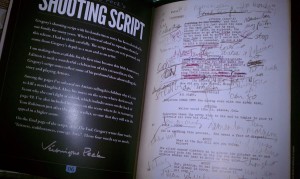New Literacies: Scriptwriting
My first job after college was in television news: I was a reporter and every day I had to write a script which was used as the guide to edit the video that would eventually become my “story” for that night’s newscast. Little did I know back in 1977 that years later I would be encouraging classroom teachers to teach their students not only about news (and other media), but also about the important role that the writing process plays in creating all media, including still and motion pictures.
Now some would argue that photography does not involve writing, but I would beg to differ. News photographers write captions explaining their images, for example. Even the great photographers Ansel Adams, Dorothea Lange and Annie Liebowitz all had plenty to say (in writing) about their iconic work. We’ve all heard the expression “a picture is worth a thousand words” — and sometimes it really requires words to fully bring visual media to life.
The need to interpret and manipulate media has been identified as one of the “new literacies,” and many educators have discovered how to engage and motivate students using both media and technology. The National Council of Teachers of English (NCTE) is among the most active educational organizations recognizing the power of visual media and is active in recommending that teachers include “non-print” texts in instruction. The new Common Core ELA standards also include references to media (although they could use more).
All media starts as writing
All media start out as writing. I made that “discovery” some years ago after reading this quote from international education consultant Heidi Hayes Jacobs:
“If video is how we are communicating and persuading in this new century, why aren’t more students writing screenplays as part of their schoolwork?”
Think about that for a moment. Our students are enamored of watching television and movies (even if how and where they watch differs dramatically today from how many adults grew up accessing those media). They see video and film all of the time. But how many of them realize that their favorite TV show or movie originated as words on a page?
In my media literacy workshops around the country, I remind educators that our students only know what they see on the screen — the final product. They rarely get a chance to witness how a production gets onto the screen — the process.
Digital storytelling begins with words on a page – be it paper or electronic. Many of our students want to push “record” on their camcorders, smart phones or e-tablets before they’ve ever written a word on a script. And that’s backwards. The script guides what’s seen (and heard) on the screen, not vice-versa.
Teachers today need to listen to Heidi Hayes Jacobs and get students involved in the kind of writing that leads to multimedia production. If you’re an educator reading this, my blunt statement might frustrate you, because you’ve probably not had any prior training that would make you more comfortable (and effective) in teaching scriptwriting or screenwriting.
I don’t want that to be an obstacle to your moving forward. After reading Jacobs’ quote, I created the “Scriptwriting In The Classroom” resource for my Media Literacy Clearinghouse website to provide teachers with some ideas, encouragement and guidance in this area. Here’s some of what I had to say.
Advertising scripts
I maintain that most ads tell a story. Consider the following:
 You see a print ad from a magazine for a new car speeding out of town. You know the car is going fast because the background has been blurred. The story — or at least what the advertiser is trying to communicate here — is that owning this new car will help you escape the confines of the hustle-and-bustle of a hectic city life.
You see a print ad from a magazine for a new car speeding out of town. You know the car is going fast because the background has been blurred. The story — or at least what the advertiser is trying to communicate here — is that owning this new car will help you escape the confines of the hustle-and-bustle of a hectic city life.
I always imagine ad writers (like the ones portrayed in AMC TV’s Mad Men) sitting around a table, brainstorming “the story” which will eventually become the words, slogans and images of the eventual ad. Of course, most of us have never actually seen the ad writers at work: we only see their completed product.
For commercials, ad writers use a two-column script with the words audio and video at the top of each column. One 8 X11 sheet of paper represents a 30-second commercial. When teachers and students begin to create a commercial, I caution them to ignore the video column (for the time being) because it is the audio (the words, sounds, music) which must be written first. What do you want your audience to know? What do you want them to remember? After the words are finalized, the script goes into production and then filming can begin, creating images best suited for the messages embedded in the script.
(At my website, you can see examples of several commercial scripts and download a two column script template.)
Ideas for The Classroom
Your students have seen thousands of ads in their lifetime (perhaps tens of thousands) but they may have never considered them as pieces of writing. So here’s a good place to start. Why not assign students different TV programs and have them document the types of ads that are shown. What do they notice about the writing going on “behind” the commercial. What words are chosen? What themes have the writers selected? (This activity also reveals demographic information: who the program is targeting.)
 If students cannot record the ads for repeated viewing, have them search for the ads on YouTube, a popular location for advertisers who hope to reach audiences beyond a specific broadcast.
If students cannot record the ads for repeated viewing, have them search for the ads on YouTube, a popular location for advertisers who hope to reach audiences beyond a specific broadcast.
Students could attempt to recreate the “script” for the ad (filling in the two column script template) and be prepared to talk about key words, phrases, sounds and other noteworthy information.
Teachers can also assign students a project in which they are given print ads for a product and tasked with creating a video script for the TV commercial. What techniques might they wish to incorporate in order to attract or persuade the audience? How can they best describe what they have mind, in writing, so that the producer/director can make the ad?
Students should consider who the audience(s) might be for the product as well as what television show, web page or movie might feature the ad. In other words, they should choose an audience and shape their work accordingly.
Screenplays: Scripts for TV & the Movies
Few ELA textbooks include any references to the scriptwriting process for television or film. As a result, most students have not been exposed to screenplays, but I believe they can learn much from them.
On my website, teachers can find a good example of what a screenplay looks like. Some time ago, I created a film study guide to the classic film To Kill A Mockingbird. A sample page from the screenplay reveals that these kinds of scripts include just two elements: dialogue and action.
Students hoping to write their own screenplays will certainly want to become familiar with the screenwriting format, as well as the most common codes and conventions. One activity for students might be to take a brief fictional story and “write the screenplay,” separating the conversational (dialogue) and descriptive (atmosphere, action) elements.
Recommended resources
Today, many new theatrical releases are accompanied by companion books which contain scripts as well as features on pre-production, scouting of locations, costumes, makeup, editing, special effects and more. A search at Amazon or Barnes & Noble will reveal many options suitable for classroom use.
 In mid-May, The Hollywood Reporter published a special Writers Issue, featuring writers from both television and film. THR profiled Damon Lindelof, the screenwriter of “Star Trek Into Darkness.” The magazine also reunited the writing staffs of “The X Files,” “Murphy Brown,” “Buffy The Vampire Slayer” and “The Shield” — some of the more iconic, and well-written television series of recent decades.
In mid-May, The Hollywood Reporter published a special Writers Issue, featuring writers from both television and film. THR profiled Damon Lindelof, the screenwriter of “Star Trek Into Darkness.” The magazine also reunited the writing staffs of “The X Files,” “Murphy Brown,” “Buffy The Vampire Slayer” and “The Shield” — some of the more iconic, and well-written television series of recent decades.
Websites such as Script-o-Rama, The Daily Script, and Simply Scripts offer opportunities for teachers and students to read actual scripts and to study some of the codes and conventions common to screenplays. Magazines such as Script and Creative Screenwriting offer timely articles and essays on contemporary films and frequently contain excerpts of screenplays.
I encourage teachers to seriously consider the need to include media-related writing in the curriculum. I think you’ll find your students actively engaged and more interested in creating their own media productions. The results might be a more active, critical viewer and consumer. And you will be helping students build a new literacy that will serve them well in a future where information creation and delivery is certain to be increasingly visual.
Frank W. Baker is a media literacy education consultant and the author of three books, including Media Literacy In the K-12 Classroom (ISTE, 2012). A consultant to the National Council of Teachers of English (NCTE), Baker maintains the nationally recognized Media Literacy Clearinghouse website and conducts media literacy workshops at conferences, schools and districts across the United States. He can be reached at fbaker1346@aol.com.




































Yes, exploring script writing opens their eyes to new possibilities. Some of my middle schoolers seemed surprised that actors were speaking the dialogue writers had provided. Writers create compelling characters seen through the actions the student’s favorite actors and singers. Many students are eager to write scripts because they understand as a writer, they are gaining some control over their environment. They appreciate that their writing can come to life, and that is a powerful experience for them.
I remember when that realization came to me: that some writers write stories and others write screenplays. I contemplated how a screenplay would look different from a story. I find it intriguing when I hear of a famous screenplay coming up for auction. They always look so dull in appearance, but can be full of director’s comments, etc. I guess it goes back to the old adage “don’t judge a book by its cover.” I will be honest in saying I have never seen a screenplay, so it would be worth a look! I understand what you say about writing coming to life. I discovered a little girl in my class last year was gifted at directing our class play. It was a surprise, but it made me realize that so many kids have undiscovered talents, and how fun it is as a teacher to see one of them find that for the first time! We may have numerous screen-writers just waiting for opportunities!
I think this was a good article. This class, in general, is opening my eyes to many possibilities to write and create even short and simple videos that tell a story. We just did an animation that correlated with a story one of my second graders wrote about a snowman. It was so fun and made me laugh! My kids were delighted with the idea: and I am delighted that the window of possibilities is open in this regard. It brings me back to realization that there are so many ways to tell a story…from one action-packed sentence or a long script or story. I think kids are very interested in movies and story-telling. The old ways of pen and paper may be used less and less as we enter into this newer arena of You Tube and instant videos. As always, teachers must be flexible in how and what we teach in order to have a captive audience. We can still grade their grammar. (Ha, Ha!)